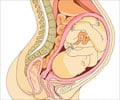One every 160 births in the United States is a stillbirth tragically.

A new test for analyzing the chromosomes of stillborn babies, known as microarray analysis, has now proven 40 percent more effective in pinpointing potential genetic causes of death than the old karyotype testing procedure. Researchers at the University of Texas Medical Branch at Galveston, along with a team of other national leaders in maternal-fetal medicine, have published their findings in the Dec. 6 New England Journal of Medicine.
"Families have a much greater sense of closure if they understand what likely caused their baby to die," said Dr. George Saade, lead investigator of the UTMB arm of the study. "And for doctors to be able to see more genetic information about each stillborn baby can only be a good thing in terms of continuing the fight to reduce stillbirths worldwide." Stillbirth, as defined separately from miscarriage, is when a baby dies in the womb prior to delivery at or after 20 weeks of gestation.
The study, part of the National Institutes of Health Stillbirth Collaborative Research Network's ongoing program, showed that microarray analysis genetic testing offers families strikingly more information than karyotyping about what potentially caused their baby to die before it was born. UTMB's Saade is the lead investigator for the study at UTMB, and chairman of the genetics committee for the Stillbirth Network.
The researchers compared the results of karyotypes from more than 500 stillbirths to results from microarray analysis, a method that detects small segments of missing parts of chromosomes (deletions) or additional sections of genetic material (duplications) that cannot be seen by karyotyping.
They analyzed samples from all stillbirths in a population-based study in five U.S. areas, covered by 59 hospitals over a period of two and a half years. Shortly after each stillbirth, parents gave research staff permission to collect blood from the umbilical cord and tissue from the fetus and the placenta.
Advertisement
If the families agreed to take part in the study, UTMB staff members then worked with the participating hospitals to transport the babies to Galveston for genetic testing and/or autopsy before arranging with funeral homes for the babies' final transport. About 100 stillbirths occurred in the Galveston/Brazoria county region during the two and a half years the study took place. "It's really something, that families in such a tough situation, with all the shock and sadness they must be feeling upon the loss of their baby, would be willing to work with us to conduct this important stillbirth research," said Saade.
"We are so glad that the data from our region was included in this important national study," said Saade. "We are proud here at UTMB that our national reputation as a leader in maternal-fetal clinical research has enabled us to be part of this Network and study, and that we were able to work with such an outstanding group of participating hospitals."
Source-Eurekalert













